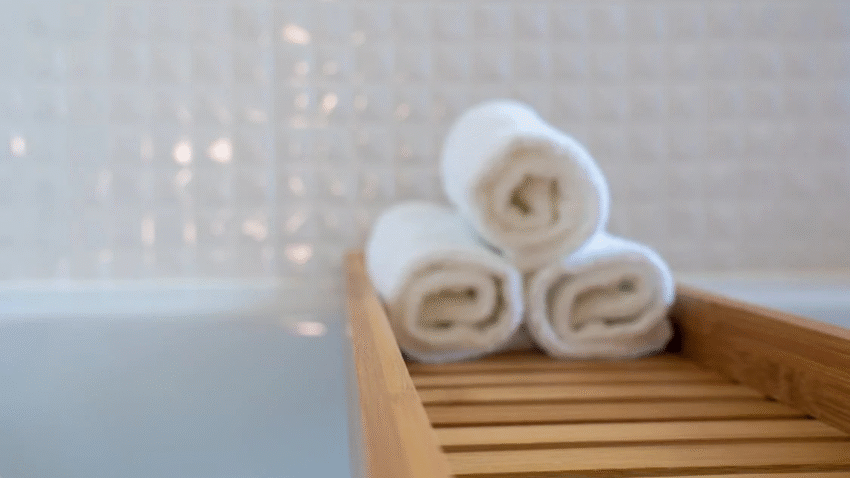Introduction
Want to upgrade your bathroom without breaking the bank or hiring a contractor? This guide on how to install peel-and-stick backsplash will walk you through a simple DIY project that adds style, protection, and personality to your bathroom walls. With no grout, no mess, and minimal tools, peel-and-stick tiles are perfect for beginners who want fast results.
Why Installing a Peel-and-Stick Backsplash Matters in the Bathroom
In bathrooms, walls behind sinks and vanities are prone to water splashes, soap scum, and humidity. A backsplash serves as a barrier to protect the wall from moisture damage while also adding a decorative touch. Traditional tile backsplash installations require messy adhesives, grout, and sometimes professional help.
Peel-and-stick backsplash tiles offer a modern alternative. They’re budget-friendly, quick to install, and ideal for bathrooms of any size. With hundreds of styles — from faux marble to classic subway tile — you can refresh your space in just a few hours, all while increasing durability and hygiene.
Step-by-Step Guide to Installing Peel-and-Stick Backsplash
1. Gather Your Tools and Materials
Before you begin, gather the following items:
- Peel-and-stick backsplash tiles
- Measuring tape
- Pencil
- Level
- Utility knife or scissors
- Straightedge or ruler
- Cleaning cloth and mild cleaner
- Sponge or plastic smoothing tool
Bathroom Tip: Buy 10% more tile than you need to account for trimming and mistakes.
2. Prepare the Surface
Peel-and-stick tiles adhere best to clean, smooth, and dry surfaces. Wipe down the wall with a mild cleaner to remove grease, dust, or soap residue. Let it dry completely.
Avoid applying tiles to textured or uneven surfaces like brick, raw drywall, or stucco. For painted walls, make sure the paint is fully cured (at least 2–3 weeks old).
3. Measure and Plan Your Layout
Measure the width and height of the area you’ll be covering to calculate how many tiles you need. Then lay out a few tile sheets on the counter or floor to test how they’ll look together. This step helps you avoid surprises, especially with patterned or mosaic-style tiles.
Pro Tip: If your tile has a repeating pattern or staggered design (like subway tile), make sure your layout accounts for visual flow.
4. Mark a Straight Line
Using a level and pencil, draw a light horizontal line across the wall where your first row will go. This will help you place the tiles evenly and avoid crooked installation — especially important in bathrooms where you’re working around sinks and mirrors.
5. Start Applying the Tiles
Peel off the backing from the first tile and carefully line it up with your pencil line. Press firmly from the center outward to eliminate air bubbles. Use a sponge, cloth, or smoothing tool to press the tile flat against the wall.
Continue adding tiles row by row. Stagger seams if needed to mimic real tile work. Be sure to press firmly along the edges to create a seamless look.
Bathroom Tip: Start from the center of the wall and work outward if symmetry is important (especially behind a mirror or sink).
6. Trim Tiles as Needed
You’ll likely need to trim tiles to fit corners, outlets, or the edge of the backsplash area. Use a straightedge and a utility knife to cut cleanly through the tile sheet. Scissors may work for flexible vinyl sheets but not for thick or rigid tiles.
Cut carefully and double-check measurements before trimming. If cutting around outlets, be sure to turn off the power first and remove outlet covers.
7. Finish the Edges (Optional)
For a polished look, consider adding edge trim or caulk around the border of the backsplash. This step isn’t required but gives a finished, professional appearance — especially in areas where the tile stops in the middle of a wall.
Bathroom Tip: Use waterproof caulk along the bottom edge where the backsplash meets the sink or vanity to prevent water from seeping behind the tiles.
Common Mistakes to Avoid
Avoid these common errors when installing peel-and-stick backsplash:
- Mistake: Not prepping the wall
Solution: Always clean and dry the wall. Dust, grease, or soap residue will prevent the tiles from sticking properly. - Mistake: Skipping the layout plan
Solution: Take time to measure and dry-fit tiles first. Poor planning leads to misaligned patterns and awkward gaps. - Mistake: Rushing the application
Solution: Work slowly and press each tile firmly for long-lasting adhesion. Smooth out bubbles as you go. - Mistake: Cutting tiles too small
Solution: Always measure twice and cut once. Small measurement errors are visible and hard to fix once stuck. - Mistake: Not sealing the edges
Solution: In bathrooms, sealing the edges with waterproof caulk prevents water damage and peeling.
Extra Tips & Bathroom Hacks
- Use a blow dryer for stubborn corners: A little heat softens rigid tiles and makes them more pliable for tight corners or uneven walls.
- Choose waterproof-rated tiles: Not all peel-and-stick tiles are made for wet areas. Look for tiles labeled “bathroom-safe” or “water-resistant.”
- Install backsplash in small sections: Breaking the job into smaller areas (one wall at a time) helps reduce pressure and improves accuracy.
👉 Love easy upgrades? Check out our guide on how to repaint bathroom walls like a pro to complement your new backsplash.
Conclusion
Installing a peel-and-stick backsplash is one of the easiest and most satisfying ways to elevate your bathroom. With a little planning, some basic tools, and a steady hand, you can achieve a high-end look in just an afternoon — no grout or contractor required. Whether you’re sprucing up a powder room or refreshing a full bath, this budget-friendly upgrade delivers big impact.
Bookmark this guide so your next bathroom DIY project is smooth, stylish, and stress-free.
